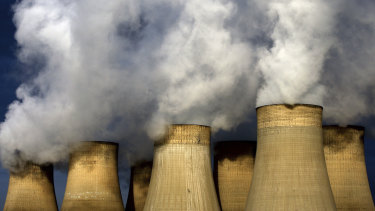Just 2 per cent of Britain's power now comes from coal. In Australia, it's more like three quarters
By Bevan Shields
January 2, 2020
London: Renewable energy has overtaken fossil fuels to become Britain's largest source of electricity in a historic shift that could signal the "beginning of the end" for coal across Europe.
National Grid data released on New Year's Day revealed coal represented just 2.1 per cent of Britain's overall electricity output in 2019.
By comparison, black and brown coal fuelled 74 per cent of Australia's energy mix in 2018.
The new figures show 48.5 per cent of the United Kingdom's energy came from zero carbon technology in 2019, while coal, gas and oil crashed to just 43 per cent - down from 75.5 per cent in 1990.
In 1990, coal alone accounted for 75 per cent of all generation. That figure fell to 30 per cent in 2009 and now stands at only 2.1 per cent following a tsunami of power plant closures and nationwide boom in wind and solar.
"As we enter a new decade, this truly is a historic moment and an opportunity to reflect on how much has been achieved," said John Pettigrew, the chief executive officer of the agency in charge of the UK's energy network, National Grid.
Just a handful of coal-fired power stations remain operational and all will be shuttered by 2025 under a plan legislated by former Tory prime minister Theresa May and embraced by her successor Boris Johnson.
Gas made up 38.4 per cent and biomass and waste 8.2 per cent last year in the UK. The country also imported about 8 per cent of its energy via undersea cables from continental Europe - the majority from green sources.
Wind, solar and hydro power totalled 26.5 per cent, while nuclear - which is classified as a zero carbon source - added 16.8 per cent to the mix.
That meant renewables pumped out 48.5 per cent of all generation in 2019 - well above the 24.4 per cent figure recorded in 1990 - in a result that eclipsed fossil fuel's dominance for the first time in history.

Coal-fired power plants are being phased out across the United Kingdom. CREDIT:PA
While renewables are on the rise in Australia, their contribution to the national energy grid is nowhere near the scale of the UK. Renewable sources grew by 25 per cent in Australia between 2017 and 2018 but their overall contribution to generation was still well below half of what it was in Britain.
Even if nuclear was removed from the UK's total renewable figure, wind, solar and hydro would still be more widely used in Britain than Australia.
London-based climate change think tank Sandbag recently highlighted how coal generation across Europe had fallen by one fifth in the first-half of 2019 alone. Half was replaced by wind and solar and the remaining slice by gas.
Dave Jones, an analyst at Sandbag, said 2019 may have been the "beginning of the end" for coal in Europe.
"Now that carbon pricing is finally working ... the economics have already shifted not only from coal to gas generation, but also from coal to clean generation," he said.
"Every country could achieve a 2030 coal phaseout, if they put their mind to it."
Britain went an entire week in May without burning coal for power for the first time since the Industrial Revolution.
RELATED ARTICLE
The royal family on Tuesday launched what Prince William dubbed "the most prestigious environmental prize in history" to find 50 solutions to climate change over the next decade.
Former Australian prime minister Malcolm Turnbull, who twice lost his leadership of the Liberal Party amid fights over carbon emissions and is a high-profile republican, said the royal initiative showed leadership.
"How remarkable is it that in the UK, the home of Edmund Burke, Thatcher and Churchill, there is consensus on the reality of global warming and the need to act," he tweeted.
"A reminder that there is nothing 'conservative' about climate denialism."
The UK's Conservative government has pledged to make the country carbon neutral by 2050.
The Australian Energy Market Operator has forecast the need for 30 gigawatts of large-scale renewable generation by 2040 to replace old coal-fired power plants, as well as 20 gigawatts of dispatchable power like quick-start gas plants, batteries or pumped hydro to back up the renewables.
---30---
No comments:
Post a Comment